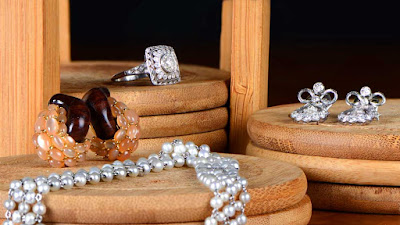Customized Jewelry Online | Personalized Gold Jewelry
Does anyone ever need a reason to buy diamond jewelry? Of course. There are plenty of reasons: to celebrate...to commemorate...to reward...to romance. Diamond jewelry is the gift for all reasons. But if you're interested in diamond jewelry, the essential four "C's" are important.
The first "C" of purchasing diamond jewelry is color. When applied to diamonds, color is often misunderstood by people outside the diamond industry. Many people think of diamonds as colorless. In reality, truly colorless diamonds are quite rare. Most diamonds used in jewelry are nearly colorless but still, have faint yellow or brown tints. These diamonds fall in the normal color range that will make your diamond jewelry purchase a great investment.
The second "C" to look at when purchasing diamond Customized jewelry Online, is clarity. Like color, clarity is a key factor in determining a diamond's value. Few things in nature are absolutely perfect. This is as true of diamonds as anything else. Diamonds have internal features called inclusions and surface irregularities, called blemishes. Together, they're called clarity characteristics. Clarity is the relative absence of clarity characteristics. Blemishes include scratches and nicks on a diamond's surface. Inclusions are on the inside (some might break the surface of the stone, but they are still considered inclusions). Sometimes, tiny diamond or other mineral crystals are trapped inside a diamond when it forms. Depending on where they're located, they might still be there after the stone has been cut and polished. Like the rest of the Four Cs, clarity's influence on value is directly related to the concept of rarity. Flawless diamonds are very rare-so rare in fact, that it's possible to spend a lifetime in the jewelry industry without ever seeing one. As you might imagine, flawless diamonds command top prices. Diamond Engagement Rings jewelry in the middle price range makes up the bulk of the retail market. That's exactly how clarity works. Sometimes, a diamond can be re-cut or polished to remove a surface blemish without noticeably reducing the stone's weight. This usually increases the diamond's value.
Diamond-Cut
The third "C" to look at is cut. You may think of cut as the shape and style of a polished diamond. But when we talk about cut as a value factor, you're also talking about the proportions, symmetry, and finish of a diamond often called "make" in the diamond trade. A diamond with a "good make" will speak to you. It's bright, fiery, symmetrical, and sparkles with light. What makes cut so difficult to evaluate is that there's more than one way of cutting a diamond to make the most of its optical properties. A well-cut diamond, with well-balanced proportions and high polish, can make light behave in breathtaking ways. The result is a magnificent display of brilliance, dispersion, and scintillation. The three major parts of a polished diamond, top to bottom, are the crown, the girdle, and the pavilion. Some polished diamonds have a very tiny flat facet at the bottom of the pavilion, called the culet. The large flat facet on the top of a polished diamond is called the table. Cutting a diamond to produce the maximum return of light depends on the interrelationship between three critical proportions - table size, crown angle, and pavilion depth. These can be combined in many ways to yield equally bright round brilliant cut diamonds for the most exquisite diamond jewelry.
The fourth "C" has to do with the basic measuring unit of diamonds. Carat weight is simply that. It's how much your diamond weighs. Diamonds are weighed to a thousandth (0.001) of a carat and then rounded to the nearest hundredth, or point. Over a carat, diamond weights are usually expressed in carats and decimals. A 1.03 carat stone, for example, would be described as "one point oh three carats," or "one oh three." A diamond that weighs 0.83 ct. is said to weigh "eighty-three points," or an "eighty-three pointer."
Generally, the more scarce a diamond is, the more it is worth. One carat diamonds are rarer than those under a carat, so they've priced accordingly and worth more in the long run when mounted on diamond jewelry. Purchasing diamond jewelry requires more thought and time than a consumer thinks, but it is definitely the purchase that will last you a lifetime.









